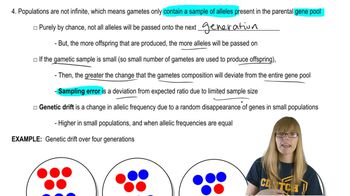Write a short essay describing the roles of mutation, migration, and selection in bringing about speciation.
Table of contents
- 1. Introduction to Genetics51m
- 2. Mendel's Laws of Inheritance3h 37m
- 3. Extensions to Mendelian Inheritance2h 41m
- 4. Genetic Mapping and Linkage2h 28m
- 5. Genetics of Bacteria and Viruses1h 21m
- 6. Chromosomal Variation1h 48m
- 7. DNA and Chromosome Structure56m
- 8. DNA Replication1h 10m
- 9. Mitosis and Meiosis1h 34m
- 10. Transcription1h 0m
- 11. Translation58m
- 12. Gene Regulation in Prokaryotes1h 19m
- 13. Gene Regulation in Eukaryotes44m
- 14. Genetic Control of Development44m
- 15. Genomes and Genomics1h 50m
- 16. Transposable Elements47m
- 17. Mutation, Repair, and Recombination1h 6m
- 18. Molecular Genetic Tools19m
- 19. Cancer Genetics29m
- 20. Quantitative Genetics1h 26m
- 21. Population Genetics50m
- 22. Evolutionary Genetics29m
21. Population Genetics
Allelic Frequency Changes
Problem 6
Textbook Question
Genetic drift, an evolutionary process affecting all populations, can have a significant effect in small populations, even though its effect is negligible in large populations. Explain why this is the case.
 Verified step by step guidance
Verified step by step guidance1
Understand that genetic drift refers to random changes in allele frequencies within a population due to chance events, rather than natural selection.
Recognize that in small populations, random sampling effects are more pronounced because each individual's genetic contribution represents a larger fraction of the gene pool.
Explain that because of this, alleles can become fixed (reach 100% frequency) or lost (0% frequency) more quickly in small populations purely by chance.
Contrast this with large populations, where the large number of individuals buffers against random fluctuations, making genetic drift's effect negligible.
Summarize that the impact of genetic drift is inversely related to population size because random events have a stronger influence when fewer individuals contribute genetically.
 Verified video answer for a similar problem:
Verified video answer for a similar problem:This video solution was recommended by our tutors as helpful for the problem above
Video duration:
2mPlay a video:
Was this helpful?
Key Concepts
Here are the essential concepts you must grasp in order to answer the question correctly.
Genetic Drift
Genetic drift is a random change in allele frequencies within a population due to chance events. It occurs independently of natural selection and can lead to the loss or fixation of alleles over time, especially in small populations.
Recommended video:
Guided course

Genetic Drift
Population Size and Genetic Variation
Population size influences the impact of genetic drift; in small populations, random fluctuations can drastically change allele frequencies, reducing genetic variation. In large populations, these random changes are diluted, making drift effects negligible.
Recommended video:
Guided course

Genomic Variation
Founder Effect and Bottleneck Effect
The founder effect and bottleneck effect are examples of genetic drift where small groups establish new populations or survive drastic reductions, respectively. Both lead to reduced genetic diversity and increased influence of random allele frequency changes.
Recommended video:
Guided course

Maternal Effect
Related Videos
Related Practice
Textbook Question
473
views


